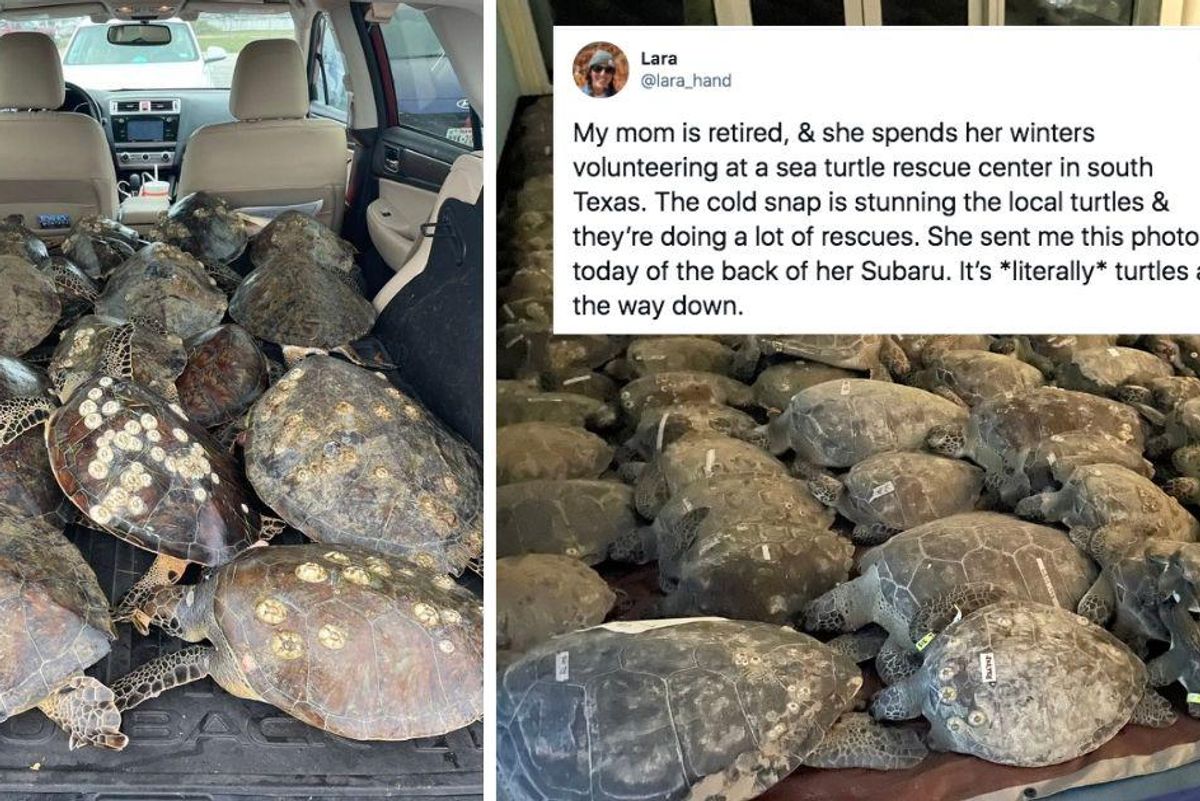Dedicated volunteers rescue over 4,500 endangered sea turtles from frigid Texas waters
As record cold temperatures continue to impact Texas, causing power outages and water shortages across the state, a group of dedicated volunteers have taken it upon themselves to rescue thousands of endangered sea turtles from the waters of South Padre Island. The resort town in southern Texas rarely gets too cold long enough to threaten sea turtles, who need warm waters to survive. But with temps dipping down to freezing and still hovering in the 40s, something had to be done to keep the creatures warm.
So far, according to NPR, nearly 4,500 sea turtles have been brought indoors since Sunday by volunteers at organizations like Sea Turtle, Inc., a sea turtle rescue operation, and the South Padre Convention Center, where the overflow of turtles are being kept. Sea Turtle, Inc. lost power, but thanks to a commercial generator brought in by SpaceX, have been able to keep their facility warm enough for the rescued turtle patients who already resided there and the influx of new rescues before they got too full to take more.
Volunteers have been working hard to save as many sea turtles as possible, even though many of these people are struggling with losing electricity, heat, and water themselves. Using their own cars and trailers, they have been transporting the turtles to safety a dozen or two at a time.
Lara (@lara_hand) on Twitter shared a thread about how her retired mother spends winters volunteering Sea Turtle, Inc. and how they're rescuing turtles during the cold snap. Her photo of the back of her Subaru filled with sea turtles drives home the dedication of the volunteers who are working to save these creatures.
Lara said her mom's team rescued more than 1,000 turtles on the 15th, one of which was over 100 years old and around 350 pounds.
Here's a video her mom shared from the convention center, showing how many turtles were being stored there already.
And more photos of the incredible rescue operation.
Sea Turtle, Inc. told the Washington Post that during a normal winter, volunteers might rescue from a few dozen to a few hundred cold-stunned turtles, so this week's effort is truly extraordinary. When a turtle gets too cold, its heart rate lowers and its body becomes paralyzed. The hypothermic shock causes them to float above the water, where they are at risk of being struck by boats, attacked by predators, or even drowning.
However, the 3,500 turtles are not out of the woods yet. The "dry dock" conditions in the convention center are not ideal, and the issue of maintaining power is vital to keep temperatures warm enough for the turtles.
Ed Caum, executive director of the South Padre Island Convention and Visitors Bureau, told the AP that he hesitates to call the effort a rescue because "we know we're going to lose some." Temperatures may not rise enough for the turtles to be returned to the water until the weekend.
"We're trying to do the best we can to save as many turtles as possible," he said.
The polar vortex that has swept through Texas and the southern U.S. has already claimed at nearly two dozen human lives in addition to an unknown number of animals. One animal sanctuary in North Bexar County, Texas has sadly lost more than a dozen animals including at least one chimpanzee as well as monkeys, lemurs, and tropical birds.
The combination of severe weather and an insufficient power grid cut off from the rest of the country has created a perfect storm of suffering in Texas this week. Seeing people helping people and animals weather that storm is heartening. Let's just hope they won't have to keep it up for much longer.
- The way these hundreds of sea turtles were rescued is nothing short ... ›
- A Bunch Of Baby Sea Turtles Are About To Steal Your Heart ... ›
- These photos of sea turtles being released back into the sea show ... ›
- AOC raised $2 million in less than 24 hours to provide aid to struggling Texans - Upworthy ›
- Group of endangered California condors wreak total havoc on a woman's porch - Upworthy ›
- Delivery guy finds baby turtle and his joy is contagious - Upworthy ›
- Upworthy celebrate Subaru with 5 things that made us smile this week - Upworthy ›
- Upworthy celebrate Subaru with 5 things that made us smile this week - Upworthy ›
- Upworthy celebrate Subaru with 5 things that made us smile this week - Upworthy ›
- Ecologist 'bursts into tears' seeing endangered gliders using replacement nests designed to save them - Upworthy ›

